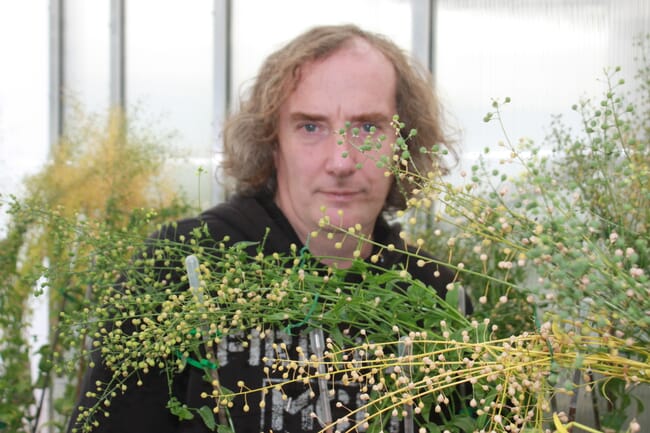Metabolic engineers researching the commercial cultivation of a transgenic variety of Camelina sativa, one of Europe’s oldest oil seed crops, have reproduced results showing that the transgenic plants can grow in the field; they have matched the seeds’ biosynthetic products more closely to those of their marine counterparts; and they have identified the potential for even greater oil storage in the seeds.
This work, published online today by Nature in Scientific Reports, comes from a collaboration between Rothamsted Research and the University of North Texas (UNT). It appears as pressure mounts on traditional supplies of fish oils, which are a key part of the diets of farmed fish such as salmon, as well as being vital nutrients for human health.

© Rob Fletcher
“Demonstrating that our GM camelina works in the field under real world conditions confirms the promise of our approach,” says Johnathan Napier, head of the Camelina Programme at Rothamsted. “Having a viable land-based source of omega-3 fish oils can really address the ever-increasing demand for these healthy fatty acids”
Genetically modified camelina, engineered with genes from marine microbes, can produce two highly sought after omega-3 long-chain polyunsaturated fatty acids: eicosapentaenoic acid (EPA) and docosahexaenoic acid (DHA).
These omega-3s are naturally produced in abundance by marine microbes and get into the human food chain via oily fish such as anchovies, mackerel and salmon. However, growing demand for the fish that provide these fatty acids, especially from the aquaculture feed sector – which accounts for a substantial proportion of the catches of species such as the Peruvian anchoveta – has so pressurised supplies that most farmed fish now contain a fraction of the omega-3s they contained 10 years ago.
“We believe that combining our expertise in advanced metabolite imaging with Rothamsted’s skills in metabolic engineering has given new insights into how seeds make different oils, and excitingly, points to new ways to boost the accumulation of important fatty acids such as these omega-3s,” says Kent Chapman, Co-Director of the BioDiscovery Institute at UNT.
The latest research records how a second year’s field trial of GM camelina in 2015 confirmed the results from the previous year. It also shows how the team was able to reduce the level of unnecessary omega-6 fatty acids in the transgenic seeds to match more closely the mix in marine fish oils.
Furthermore, the latest research highlights the previously unrecognised and huge untapped space in camelina seeds for accumulating fish oils. Currently, valuable EPA & DHA accumulate in only the radicle of the transgenic seed, leaving the majority of the seed’s cotyledon untapped and empty of omega-3s.
“It is very significant that we can tailor camelina oil to accumulate omega-3 fish oils and that this trait is stable in field-grown plants. Furthermore, our new and unexpected insights into fatty acid accumulation across the seed points towards further opportunities to optimise this,” says Prof Napier. “I am convinced that transgenic plants such as ours can help reduce the pressure on oceanic sources of fish oils, and this study brings that one step closer to reality.”
Funding for the work came from the Biotechnology & Biological Sciences Research Council in the UK; the imaging studies were supported by the US Department of Energy and the Hoblitzelle Foundation.


